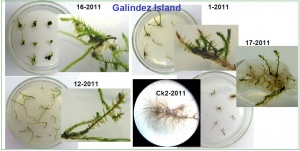In vitro Antarctic and Subantarctic Mosses
Interest in the study of Antarctic plants is associated with extreme conditions of this region and the influence of complex abiotic stress factors on their growing. Plants growing in vitro can serve as a model on which one can study the effect of stress factors. In addition, in vitro maintenance of the collection allows the physiological, biochemical and molecular biological studies of Antarctic plants without damaging their natural population.
The collection of plants includes vascular plants and mosses from wide area of Antarctic islands and from continental Antarctica. These plant samples were collected from 29.12.2010 to 05.02.2011 on Antarctic Peninsula (Brown Bluff, Prospect Point Station) and on islands of Galindez, Peterman, Deception, Weddell, Barrientos, and Ushuaia.
Plant shoots were surface sterilized under routine procedure (10 sec 70% ethanol; 1- 5 min “Belizna”; 60 min sterile H2O). The shoots were transferred to 1/2MS medium (Murashige, Skoog, 1962) and cultivated in in vitro conditions (16-hour light photoperiod, 24C) with subcultivation every two weeks.
Research work on creation of in vitro collection of the representatives of Antarctic flora has been started in 2009. Now (in April 2011) the collection includes 34 specimens (vascular plants and mosses).
Methods of surface sterilization and in vitro micropropagation of different Antarctic mosses were optimized. Most species of mosses from Antarctic islands and Antarctic Peninsula were very sensible to the conditions of surface sterilization.
In vitro multiplication of mosses differed markedly. Growth of shoots of No16-2011, 12-2011,1-2011,3-2011, 19-2011 began in 3-10 days. Shoot growth of samples 6-2011, Ck2-2011, 2-2011, 18-2011 was not detected. However formation of strongly branched protonema was observed. Protonema was sprouted or not into agarized semisolid medium.
Through 20-40 days the buds were forming on the protonema and new plants have regenerated from these buds. Thus, moss propagation in vitro has characterized by growth of lateral shoots or formation of primary protonema with subsequent bud and shoot production.
In vitro collection allows carrying out a number of systemic researches of Antarctic Region plants without disturbance of its natural populations. The in vitro plants from large-scale area (Galindez, Peterman, Deception, Weddell, Barrientos islands., Antarctic peninsula and Ushuaja) give the opportunity to study the phylogeny of Antarctic plants and to provide research work in DNA-barcoding.
Logistic and financial support of National Antarctic Scientific Center of Ukraine





